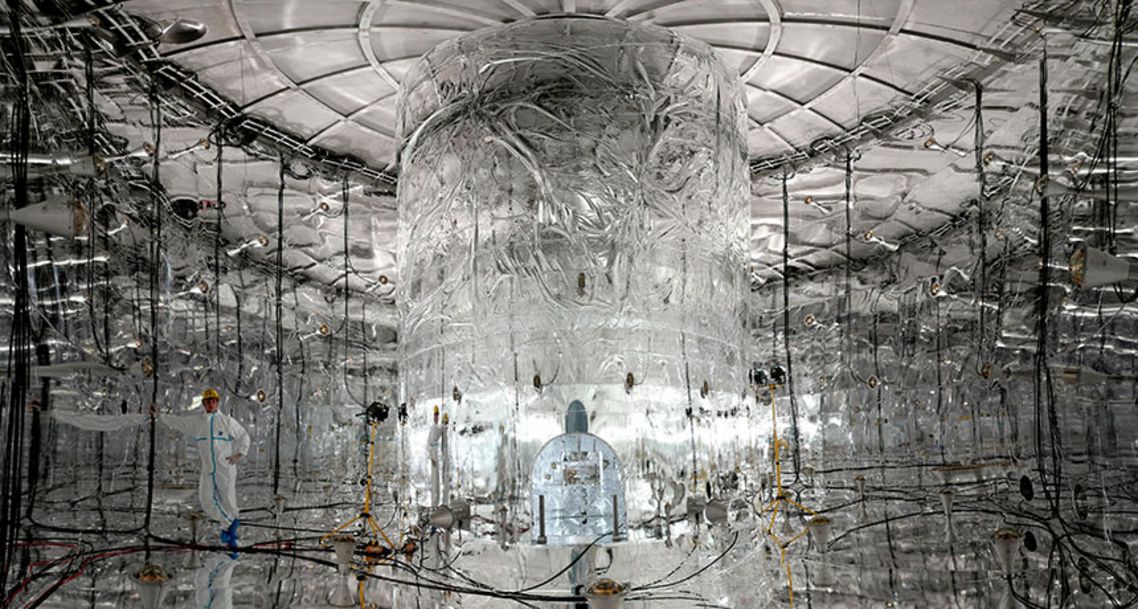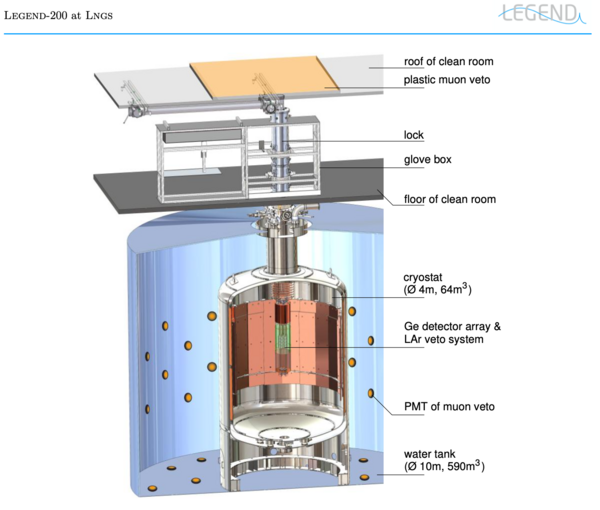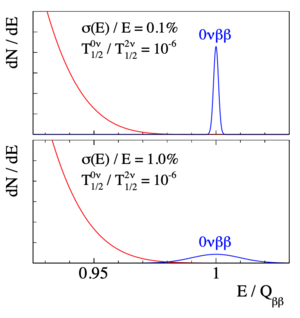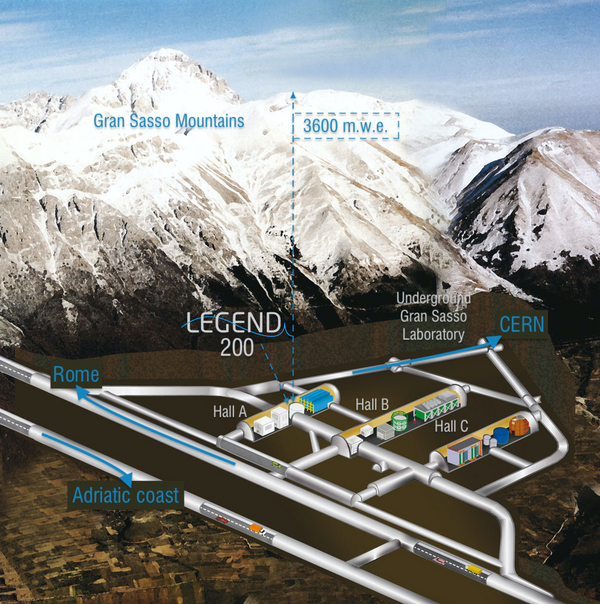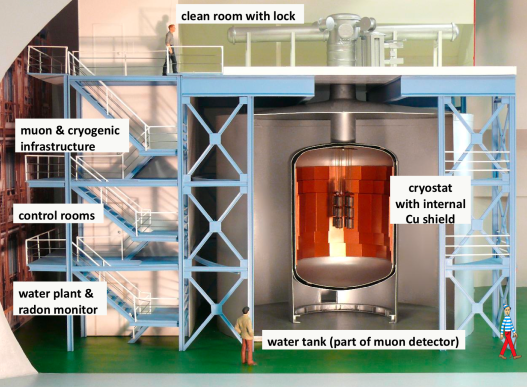La Galerie des Glaces
This photograph shows the vessel housing the experimental volume. The vast tank is filled with 590 m3 of ultra-pure water and is part of the GERDA infrastructure which will host LEGEND-200. The tank is wrapped with reflective foil to maximise the light collection for the cosmic-ray veto. The liquid argon cryostat inside the water tank is where the germanium detector array will be suspended.
External & Internal battles:
There is a multitude of processes happening in our environment that far surpass the rate of double beta decay, and especially the decay without neutrinos. Environmental radioactivity and cosmic radiation produce backgrounds that may enshroud the sly signal.
This elusiveness poses a challenge for an unambiguous detection, requiring both an ultra-low well-understood background and highest detection efficiency and sensitivity.
Searching for a needle in a haystack is easy peasy lemon squeezy compared to the stressy depressy lemon zesty search for neutrinoless double beta decay. However, detecting 0νββ decay is far more interesting and rewarding! So let’s understand the challenges ahead.
The signature of 0νββ decay is a tiny mono-energetic peak at the end of the Standard Model allowed ββ-spectrum. Hence, it is necessary to have a clear picture of this endpoint energy region.
Background processes that could hide the 0νββ signature can be grouped into internal and external sources. External sources require the detector to be shielded and necessitate its location, deep underground. Internal sources on the other hand come from minute quantities of radioactive elements in the very material used to build the experiment. As such, very radio-pure material is sourced to construct LEGEND.
► Background mitigation strategies
Whilst the external background comes from environmental and cosmic radioactivity, the internal background arises from radioactive isotopes within the setup itself, making it even harder to suppress.
A variety of strategies, materials and techniques allow the reduction of the internal and external backgrounds: an elaborate selection of the radio-purest materials, passive-shielding layers around the detectors array, and active-background identification help mitigate signals from unwanted origins.
► The Perfect Experiment
Highest detection efficiency & Best signal separation
As the search for 0νββ decay is a search for single signal events from a macroscopic amount of typical rather precious isotope material, it is worthwhile to take a step back and imagine the perfect 0νββ decay experiment:
- The isotope production is large. If not high in natural abundance, a cost-effective process for enrichment is established.
- The detection efficiency is high, while little of the ββ isotope is used for shielding purposes. This is typically achieved in a detector = absorber configuration, where the isotope is by itself, or at least directly embedded in, the detector material3. Little self shielding requires a radio-pure surrounding and clean support structures.
- The matrix the isotope is contained in features low intrinsic background, especially at the Qββ value of the decay. If background is present, it can be identified as such and properly understood. As a proper energy resolution ∆E narrows down the region the “needle” is searched for, also this way the “haystack” is reduced.
- The detection technique is able to identify the 0νββ signature without doubt. It features excellent energy resolution for the summed electron emission. Even though it has only little strength at the end-point, 2νββ decay represents an unavoidable ultimate background.
► LEGEND-200 Approach
The first stage of LEGEND will be installed in the GERDA experimental infrastructure, under 1400 meters of rock provided by the Gran Sasso mountain, in the National Park Monti della Laga in central Italy. Being not only a beautiful place to hike, the whole mountain also serves as a shield in the Gran Sasso underground laboratory against high energy radiation from the cosmos and the atmosphere.
Inside the mountain, we encounter natural environmental radioactivity omnipresent in the rock surroundings. It is for this reason that a big part of the experimental infrastructure consists of shielding layers that protect the detectors from this environment. It is indispensable for the materials used to shield and to build the experiment to contain as few as possible contaminants.
For all these reasons, the experiment will be contained inside an enormous tank filled with ultra-pure water↑ that protects the detectors from neutrons and allows the identification of residual muons. Inside this tank, a big cryostat filled with liquid argon (LAr) will host the LEGEND germanium detectors. The LAr not only serve as a high purity shield and a coolant for the detectors, but it is also instrumented to represent a detector by itself. It acts as an active-veto1 for the unwanted radiation. The LAr efficiently cools the germanium crystals to about 88 K (-186 ºC), which makes their excellent energy resolution attainable, enabling correct and precise signal identification.
LEGEND detectors are high-purity germanium (HPGe) detectors, that are made from a material that is enriched in 76Ge. They act both as the absorber and as the double beta source. The HPGe detectors have an excellent spectroscopic performance, provide event topology information and have an outstanding radiopurity. These characteristics are paramount for the search of 0νββ decay. The detector mountings are made from as little material as possible, and consist of highly-pure underground-electroformed copper as well as silicon or/and PEN (Polyethylene naphthalate).
Further background suppression requires even more creative strategies that enable active reduction of the intrinsic radioactivity. The way this is done is by analysing the detected event topology with a technique called active background rejection. The event topology discrimination technique is one of the most important strategies to identify the internal background. This technique follows from the various distinctive signatures different populations of events produce in the Ge-detectors, which allows their identification as background events. We also already mentioned that the LAr also serves as a detector. This means the following:
When there is an energy excess in the LAr, the liquid scintillates emitting light. The signal from a neutrinoless double beta decay would not generate such light; therefore, the detected light is used as a veto allowing to reject the events which are accompanied by light.
All combined, the ultra-low background environment with the active background rejection techniques make possible the reduction of background to the levels that permit the unambiguous identification of the 0νββ-decay signal.
Find out more about background below:
-
On background, Symmetry Magazine
-
1,000 meters below, Symmetry Magazine
-
3E. Fiorini et al., “A search for lepton non-conservation in double beta decay with a germanium detector”, Physics Letters B, vol. 25, no. 10, pp. 602–603, 1967.
Shielding layers
Energy resolution
The Gran Sasso National Laboratory
The underground laboratory is located under the Gran Sasso mountains at a depth of 1400 m of rock wich corresponds to about 3500 meters water equivalent (m.w.e.). The rock above the laboratory shields the experiments from high energy cosmic radiation, providing optimal conditions to search for the rarest events like the 0νββ decay. In particular, the overburden removes the hadronic components of cosmic ray showers and reduces the muon flux at the experiment by six orders of magnitude, to ~1 muon per square meter an hour. LEGEND-200 will be hosted at the former GERDA infrastructure in Hall A. This infrastructure offers a passive shielding composed of a vast tank holding 590 m3 of ultra-pure water which contains a cryostat filled with 64 m3 liquid argon where the detectors will be placed. Above the water tank there is a clean room with a glove box and lock, used for the assembly of germanium detectors into strings and the integration of the LAr veto system.

